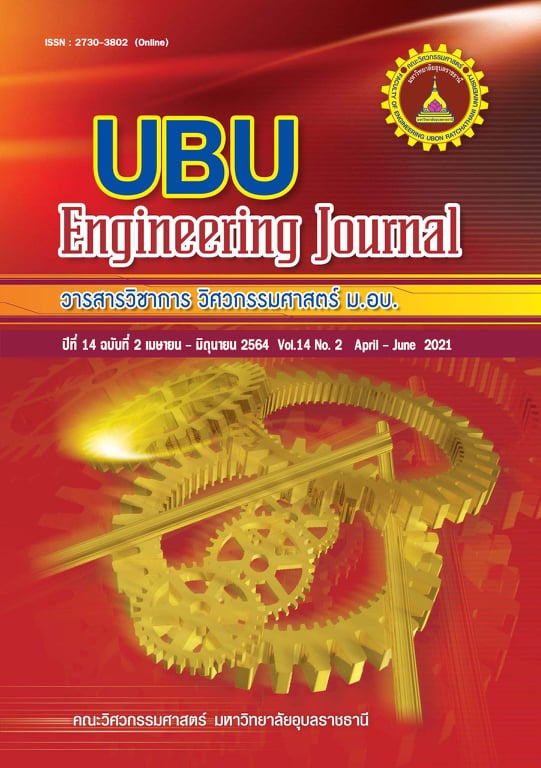Anti-bacterial property of gac fruit aril extract and para rubber film mixed with gac fruit aril extract
Main Article Content
Abstract
This research work was a study of Lycopene extraction from Gac fruit aril by ultrasonic techniques and using ethanol as extracting solvent. Para rubber films mixed with the Gac fruit aril extract were prepared by solvent casting method. The lycopene content in the Gac fruit aril extract was analyzed by HPLC technique. The Gac fruit aril extract as well as Para rubber films mixed with Gac fruit aril extract were tested for antibacterial activity of Staphylococcus aureus (S. aureus) and Escherichia coli (E. coli). Result from HPLC analysis indicated that maximum lycopene content of 2.2069 mg/g of fresh Gac fruit aril was obtained. Results from antibacterial test of Gac fruit aril extract showed that the value of minimal inhibitory concentration (MIC) and minimal bactericidal concentration (MBC) of E. coli were similar and they were equal to 50 mg/mL. Whereas the MIC value of 12.5 mg/mL and the MBC value of 25 mg/mL were found for S. aureus. All formulations of Para rubber film mixed with the Gac fruit aril extract could prohibit the growth of S. aureus greater than E. coli. Among the 5 formula of Para rubber film, the Para rubber film REGP6 (the 5th formula) illustrated the best antibacterial activity in both E. coli and S. aureus with the average inhibition zone of 0.71 ± 0.51 and 1.74 ± 0.27 mm, respectively. Furthermore, Para rubber film REGP6 with 30 days of storage showed a reduction of growth inhibition capability of 57% in S. aureus compared to Para rubber film REGP6 with 1 day of storage.
Article Details
References
[2] Sies H, Stahl W. Vitamins E and C, β-carotene, and other carotenoids as antioxidants. American Journal of Clinical Nutrition. 1995;62(6 SUPPL.).
[3] ปิยะมาศ บุญเพ็ง. การศึกษาฤทธิ์ต้านอนุมูลอิสระของสารสกัดเยื่อหุ้มเมล็ดฟักข้าวโดยใช้เทคนิคไมโครเวฟ. วิทยานิพนธ์วิทยาศาสตรมหาบัณฑิต สาขาวิชาวิทยาศาสตร์เครื่องสำอาง, มหาวิทยาลัยแม่ฟ้าหลวง. 2555.
[4] Vuong LT, Franke AA, Custer LJ, Murphy SP. Momordica cochinchinensis Spreng. (gac) fruit carotenoids reevaluated. Journal of Food Composition and Analysis. 2006;19: 664–668.
[5] Tao Y, Wu D, Zhang Q. Ultrasound-assisted extraction of phenolics from wine lees: Modeling, optimization and stability of extracts during storage. Ultrason Sonochemistry. 2014;21(2): 706–715.
[6] Phaechamud T, Issarayungyuen P, Pichayakorn W. Gentamicin sulfate loaded porous natural rubber films for wound dressing. International Journal of Biological Macromolecules. 2016;85: 634–644.
[7] Neelapong W, Phonyotin B, Sittikijyothin W. Extraction of Active Compounds from Thai Herbs: Powder and Extract. The Journal of KMUTNB. 2018;29(1): 157–166.
[8] Rattanapanudda N, Imuri P, Kumming W. Effect of ultrasonic on extraction lycopene from Gac (Momordicaco chinchinensis) fruit aril. วารสารวิทยาศาสตร์และเทคโนโลยีมหาวิทยาลัยมหาสารคาม. 2556;9: 841–846.
[9] Kubola J, Siriamornpun S. Phytochemicals and antioxidant activity of different fruit fractions (peel, pulp, aril and seed) of Thai gac (Momordica cochinchinensis Spreng). Food Chem. 2011;127(3): 1138–1145.
[10] Collins C, Lyne P, Grange JM, Falkinham III JO. Microbiological Methods. London: Arnold, a member of the Holder Headline Group;
[11] Jorgensen JH, Ferraro MJ. Antimicrobial Susceptibility Testing: A Review of General Principles and Contemporary Practices. Medical Microbiology. 2009;49(11): 1749–1755.
[12] Ge B, Wang F, Sjölund-Karlsson M, McDermott PF. Antimicrobial resistance in Campylobacter: Susceptibility testing methods and resistance trends. Journal of Microbiological Methods. 2013;95(1): 57–67.
[13] ธนวรรณ ศรีสกุลดิศ. การศึกษาความเป็นไปได้ในการสกัดสารไลโคปีนจากฟักข้าวด้วยตัวทำละลายที่เป็นมิตรกับสิ่งแวดล้อม. วิทยานิพนธ์วิทยาศาสตรบัณฑิต สาขาวิชาเคมี, มหาวิทยาลัยเทคโนโลยีราชมงคลกรุงเทพ. 2556.
[14] Kubola J, Meeso N, Siriamornpun S. Lycopene and beta carotene concentration in aril oil of gac (Momordica cochinchinensis Spreng) as influenced by aril-drying process and solvents extraction. Food Research International. 2013;50(2): 664–669.
[15] Akkarachaneeyakorn S, Boonrattanakom A, Pukpin P, Rattanawaraha S, Mattaweewong N. Extraction of Aril Oil from Gac (Momordica cochinchinensis Spreng) Using Supercritical Carbon Dioxide. Journal of Food Processing and Preservation. 2017;41(5): 1–12.
[16] Soria AC, Villamiel M. Effect of ultrasound on the technological properties and bioactivity of food: A review. Trends in Food Science and Technology. 2010;21(7): 323–331.
[17] Laohakunjit N, Noomhorm A. Effect of Plasticizers on Mechanical and Barrier Properties of Rice Starch Film. Starch. 2004;56: 348–356.
[18] Pitiphatharaworachot S, Puangsin B. Effect of Glycerol on Physical and Thermal Properties of Tapioca Starch Films. ใน: การประชุมทางวิชาการของมหาวิทยาลัยเกษตรศาสตร์ ครั้งที่ 55. 2560.
[19] Pichayakorna W, Suksaereea J, Boonmea P, Amnuaikita P, Taweepredab W, Ritthidej GC. Nicotine transdermal patches using polymeric natural rubber as the matrix controlling system: Effect of polymer and plasticizer blends. Journal of Membrane Science. 2012;411–412: 81–90.
[20] Ranjbar A, Ranjbar E. Antimicrobial Property of Lycopene Oleoresin on some Food Pathogens Running Head: Lycopene oleoresin antibacterial potent. Iranian Food Science and Technology. 2016;12(3) :382–387.
[21] นงลักษณ์ สุขวาชย์ศิลป์ และธิดา นิงสานนท์. กลุ่มไซโปรฟลอกซาซิน (Ciprofloxacin) ออกฤทธิ์ยับยั้ง เซลล์แบคทีเรีย Escherichia coli. โครงการคลังข้อมูลยา คณะเภสัชศาสตร์ มหาวิทยาลัยมหิดล. 2532;(4): 33-34.
[22] Nupan B, Thipwong J, Saisa-ard K, Samala S. Phytochemical and Antibacterial Studies of the Crude Leaves’ Extract from Limnophila rugosa (Roth) Merr . วารสารพืชศาสตร์สงขลานครินทร์. 2016;3: 26–33.
[23] นิรมล ธรรมวิริยสติ, นันทา คุมคณะ, พฤกษา อินนอก, จิราพร จรอนันต์. ฤทธิ์นอกกายของสารสกัดผลมะเขือเทศสีดาและผลมะเขือเทศราชินีในการต้านจุลชีพก่อโรค. Srinagarind Medical Journal. 2017;32(4): 359–365.
[24] Phaechamud T, Lertsuphotvanit N, Issarayungyuen P, Chantadee T. Design, fabrication and characterization of xanthan gum/liquid- loaded porous natural rubber film. Journal of Pharmaceutical Investigation. 2019;49(1): 149–160.

